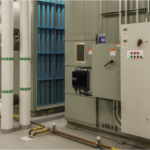Laurie: Hi, this is Laurie McCabe from SMB Group, and today I’m talking to Jason Shepherd, who is Director of strategy and partnerships for Dell’s new Internet of Things (IoT) division, as part one of a two-part blog series.
In this first post, we’ll discuss Dell’s IoT strategy, and how Dell has structured its IoT partner programs. In the second (ADD LINK), we talk about the top challenges IoT partners face, how Dell helps address these challenges, and get an update on Dell’s IoT contest.
So to start, can you give me a high level overview of Dell’s IoT strategy?

Jason: Sure. Our strategy is to be the leader in open, scalable IoT infrastructure that enables successful solution deployments. Dell is one of the few companies in the world that have a little bit of everything needed for an IoT stack. We have broad relationships and partnerships that we will continue to grow to accelerate IoT adoption.
First, we decided that while consumer IoT is interesting, our focus is on commercial and industrial use cases. Some high level vertical focus areas include building automation, manufacturing, and transportation.. Specific use cases include remote monitoring and control within these environments, asset management, process and quality controls, fleet management, logistics and many more.
 The core purpose of IoT is performing analytics on the data that you capture to yield some benefit or ROI. But one of the biggest challenges developers face is getting to the data, especially from existing systems. So we designed Dell’s Edge Gateway 5000 Series to bridge these systems to the Internet first and allow you to connect to more new equipment as you go. Dell’s gateways can also perform analytics on data locally so only meaningful information is relayed to the data center or cloud, so you’re not flooded with noise. Our strategy is to drive intelligence and capabilities to the edge in industrial use cases so people can get the data and build value on top of it. Our edge gateways fill a critical gap in the market for purpose-built products that can reliably withstand harsh industrial environments, yet come at attractive price points and are backed by Dell’s brand and global presence and support.
The core purpose of IoT is performing analytics on the data that you capture to yield some benefit or ROI. But one of the biggest challenges developers face is getting to the data, especially from existing systems. So we designed Dell’s Edge Gateway 5000 Series to bridge these systems to the Internet first and allow you to connect to more new equipment as you go. Dell’s gateways can also perform analytics on data locally so only meaningful information is relayed to the data center or cloud, so you’re not flooded with noise. Our strategy is to drive intelligence and capabilities to the edge in industrial use cases so people can get the data and build value on top of it. Our edge gateways fill a critical gap in the market for purpose-built products that can reliably withstand harsh industrial environments, yet come at attractive price points and are backed by Dell’s brand and global presence and support.
The other thing that drives our strategy is the notion of fostering IT and OT (operations technology) convergence. Many times IoT solutions are purchased by a non-IT entity, whether it’s OT, facilities, or even the marketing organization. These folks can find it difficult to get the IT support they need on the network to bridge their “things,” such as equipment and sensors, to the Internet. Meanwhile, IT departments are often wary of adding more technology from brands they don’t know to their network, due to security and management concerns. Dell has been deployed in IT environments for a long time, has built strong credibility with IT, and can help bridge these conversations and foster OT and IT cooperation and convergence.
 So we can help OT be more successful while also calming IT’s concerns, and enable IT to manage and support these systems.
So we can help OT be more successful while also calming IT’s concerns, and enable IT to manage and support these systems.
In fact, even partners that are rebranding our systems are saying, “Hey, I still want it to say ‘Built on Dell’ because it means something to IT when I bring it in.”
Laurie: Good segue to dive into specifics on Dell’s IoT partnership initiative. How is it structured and why?
Jason: Well, IoT is still in the buzz cycle. It’s early in terms of what it represents, and the landscape is really fragmented. There are many different platforms and solutions, which is great, but can also make it difficult for customers and solution providers to navigate.
In addition, many partner programs out there are structured like traditional channel programs, in which partners that pay more are in higher tiers and get preferential treatment and visibility. We think the IoT market is too immature for the typical partner program approach where partners pay fees. Even just certifying products is tricky when these solutions are so complex.
Dell’s IoT partner program does have multiple tiers, Executive, Associate and Registered, but tiers are based on the partner’s ability to perform in the market. We want to help customers find the right partners, versus just throwing everybody into a big bucket and seeing what happens. With this structure, we can help reduce some of the fragmentation problem. We curate Dell’s IoT partnerships based on factors such as maturity, solution value and differentiation, and will add mechanisms to help partners move up in status.
For instance, our entry-level Registered partners are doing very interesting things that warrant us helping them drive awareness, but we haven’t had enough experience with their solution to broadly recommend them into Dell’s customer base. Moving up, partners at our Associate tier offer more differentiated and proven solutions, whether through great integration, scalability, established channels or other factors. Highly strategic companies that offer clear differentiation, best in class solutions, and a proven ability to execute are in our top Executive tier.
Laurie: So, there’s room for the new innovators.
Jason: Absolutely, the main point is that we don’t allow providers that haven’t yet proven themselves to pay their way into more prominent placement, because this wouldn’t help end-customers make a good decision about who to work with. Instead, partners are vetted on ability to execute and overall maturity. It’s definitely more of a lift for Dell, but it’s a better service to the end customers. It’s by merit and demonstrated ability to solve customer problems, including providing support after the sale.
Laurie: What other partner attributes are relevant to Dell in the IoT space?
Jason: Since much of our initial go to market strategy is based on our new purpose-built edge gateways, our initial focus has been on partners that build software platforms that leverage gateways in their solutions. Another partner type are makers of cloud platforms that don’t have a strategy for edge data integration and analytics today, but realize that they need one because you can’t send all of your IoT data to the cloud because it gets expensive. For these cloud platform partners, we can bridge to the edge and provide value there. We’re also building partnerships with pure-play visualizataion providers and analytics companies that complement other partners and our own Dell Statistica offering with capabilities such as stream processing, video analytics and artificial intelligence.
Laurie: So, these different types of providers could be laid out across the different tiers based on maturity and strategic importance?
Jason: Yes. The one exception is with security tools. Dell has a broad security portfolio that IT trusts, but we’re always on the lookout for new solutions that address some of the net-new challenges at the edge. But we are not adding entry-level security partners – companies are either offering strategic value or they’re not. We take security very seriously.
Laurie: Makes sense! So, why are partners choosing to work with Dell in the IoT area?
Jason: Many IoT providers will participate in multiple partner programs. But Dell is attractive for a few reasons. First, we have a very broad customer base, and we’re very in tune with our customer needs. Even at the entry partnership level, when we flat-out set expectations that we will not recommend or directly sell the partner’s solution, they want to work with us to gain visibility. Being tied to the Dell brand, and the IT credibility that we talked about, and our global presence and support, are key. Many IoT innovators are very small, so this credibility really helps them. In addition, partners like that we provide choice and we’re open in how we do things.
People also like that Dell has such a strong hardware base, providing something tangible to attach their software to. Many partners are looking at appliance-type IoT models. Dell has been doing that with PCs and servers for a long time, and we can also do it for IoT with the Edge Gateway Series. Through our configuration services, partners can have software pre-installed, so their customers can simply purchase gateways directly from Dell, load them on trucks, and install them in the field. We also have ISV partners that are OEMs. They use our hardware and sell their own branded solution. Of course, there’s also attraction to the potential for co-marketing and joint selling. But, like I said, we can’t do that for everybody. We would only do that for people further up in the tiers.
This is the first of a two-part blog series on Dell’s new Internet of Things (IoT) division and partnership programs, sponsored by Dell.

0 thoughts on “Dell’s IoT Strategy and Partner Programs: Part One”